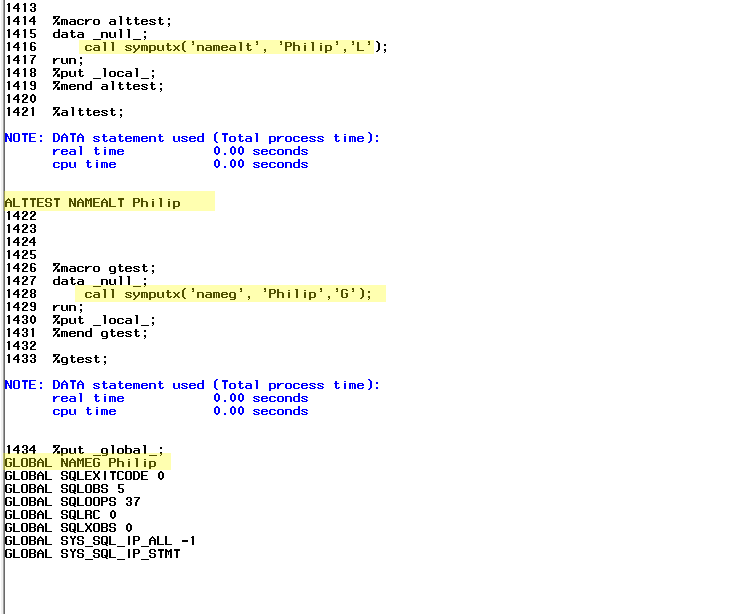- Home
- /
- Programming
- /
- Programming
- /
- global macro variable using call symput in macro defintion
- RSS Feed
- Mark Topic as New
- Mark Topic as Read
- Float this Topic for Current User
- Bookmark
- Subscribe
- Mute
- Printer Friendly Page
- Mark as New
- Bookmark
- Subscribe
- Mute
- RSS Feed
- Permalink
- Report Inappropriate Content
% macro test;
data _null_;
call symputx('name', 'Philip')
run;
%mend test;
%test
%put _global_;
I thought call symputx creates local macro variable in the macro definition. After checking name is global macro variable. I appreciate clarification in this.
Thank you.
Accepted Solutions
- Mark as New
- Bookmark
- Subscribe
- Mute
- RSS Feed
- Permalink
- Report Inappropriate Content
Hi:
There is a search path that is used to determine whether you create your macro variable in a GLOBAL or LOCAL table. You need to read about it in the documentation. When inside a macro that does not otherwise need/create a local table, your macro variable will be written to the global table. The beauty of CALL SYMPUTX is that you can CONTROL where the macro variable will be written. See the attached screen shot. The 3rd argument to the call routine allows you to specify a string that is the location: "L" for local or "G" for global or Your macro definition does not use or create a LOCAL symbol table. 'F' means write it in the most local table IF the macro variable is found. Look at the attached screen shot for an example of using 'L' and 'G' -- that's where I would recommend starting.
cynthia

- Mark as New
- Bookmark
- Subscribe
- Mute
- RSS Feed
- Permalink
- Report Inappropriate Content
Hi:
There is a search path that is used to determine whether you create your macro variable in a GLOBAL or LOCAL table. You need to read about it in the documentation. When inside a macro that does not otherwise need/create a local table, your macro variable will be written to the global table. The beauty of CALL SYMPUTX is that you can CONTROL where the macro variable will be written. See the attached screen shot. The 3rd argument to the call routine allows you to specify a string that is the location: "L" for local or "G" for global or Your macro definition does not use or create a LOCAL symbol table. 'F' means write it in the most local table IF the macro variable is found. Look at the attached screen shot for an example of using 'L' and 'G' -- that's where I would recommend starting.
cynthia

April 27 – 30 | Gaylord Texan | Grapevine, Texas
Registration is open
Walk in ready to learn. Walk out ready to deliver. This is the data and AI conference you can't afford to miss.
Register now and lock in 2025 pricing—just $495!
Learn how use the CAT functions in SAS to join values from multiple variables into a single value.
Find more tutorials on the SAS Users YouTube channel.
SAS Training: Just a Click Away
Ready to level-up your skills? Choose your own adventure.


